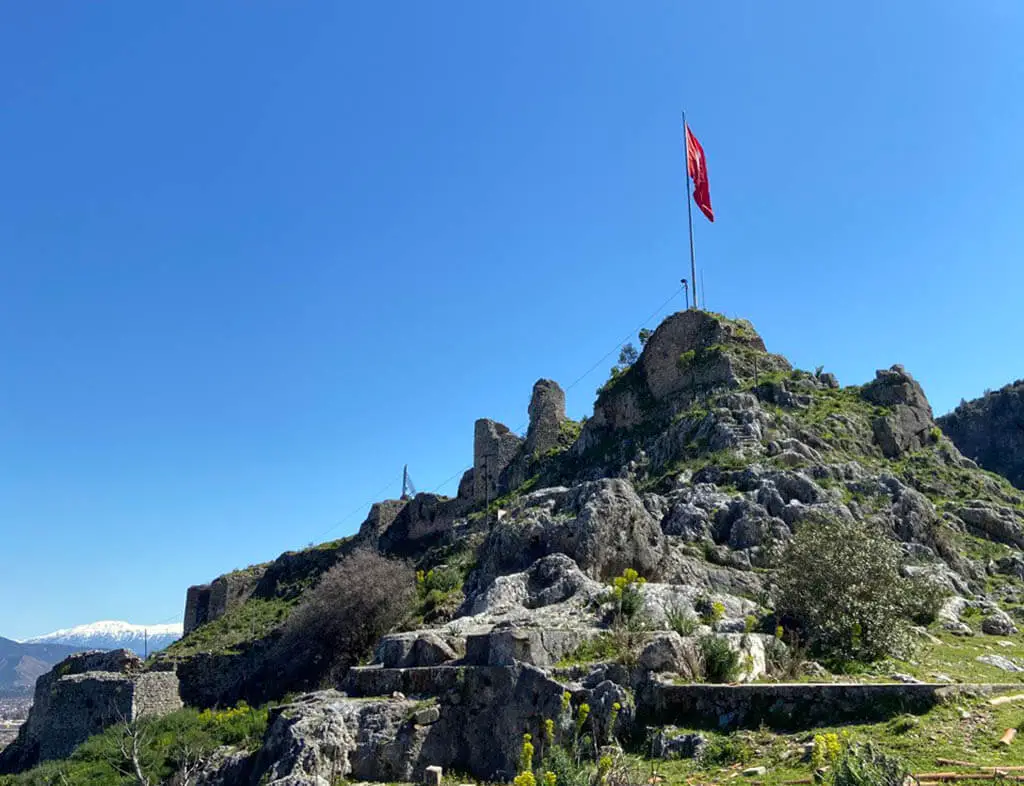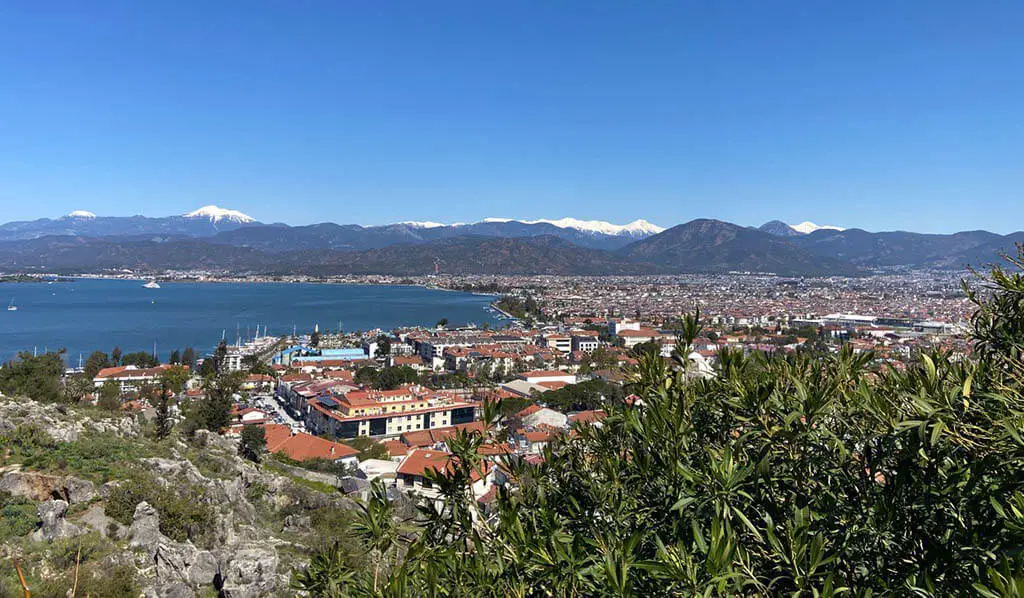Fethiye Castle: A Remarkable Historical Site in Turkey
Table of Contents
ToggleFethiye Castle is located in the picturesque coastal town of Fethiye, Turkey, which is renowned for its natural beauty and historical sites.
The castle was originally built during the time of the ancient Lycian city of Telmessos. This ancient city was the largest and most important in the Lycian region, making the castle a significant structure for the area.
The Castle of Fethiye has witnessed several transitions in its history. During the Byzantine period, it underwent significant reconstruction, and later, it was taken over by the Knights of St. John.
Importance of the castle in regional history
Fethiye Castle is an excellent example of defensive architecture, featuring imposing walls, towers, and other fortifications that have protected the area throughout history.
The castle has long been a symbol of power and control in the region. As a stronghold, it played a crucial role in maintaining the safety and security of the people living nearby.

Fethiye Castle is not only important for its defensive capabilities but also for its cultural and historical significance.
The castle bears witness to the rich and varied history of the region, from the ancient Lycians to the Byzantines and the Knights of St. John.
Architectural features of Fethiye Castle
Fethiye Castle is divided into two main sections: the Inner Castle and the Outer Castle.
The fortress is surrounded by defensive walls and features several watchtowers that were used to monitor the surrounding area and protect the castle’s inhabitants.
Inner Castle and Outer Castle
The Inner Castle occupies an elevated position and consists of living quarters, storage rooms, and a chapel.
The Outer Castle, on the other hand, is a larger area enclosed by additional defensive walls and includes a cemetery, as well as ruins of various structures.
The castle’s defensive walls and watchtowers were built using local limestone, which provided excellent strength and durability.
These fortifications have been crucial in protecting the castle and its inhabitants throughout history.
Inner Castle
The Inner Castle’s elevated position provides a strategic advantage, offering a clear view of the surrounding area and making it difficult for attackers to approach unnoticed.
The Inner Castle includes living quarters for the castle’s inhabitants, storage rooms for supplies, and a chapel, which served the religious needs of the occupants.
These spaces reflect the architectural influences of the Lycian, Byzantine, and Knights of St. John periods.
The architectural style of Fethiye Castle reflects the diverse history of the region, with elements from the Lycian, Byzantine, and Knights of St. John periods.
This blend of styles is evident in the design of the castle’s walls, towers, and other structures.
Outer Castle
The Outer Castle features additional defensive walls that provided extra protection to the fortress.
These walls are adorned with inscriptions and symbols, showcasing the different rulers and influences that have shaped the region’s history.
The cemetery and ruins found within the Outer Castle offer further insight into the lives of those who lived and died in the region.
The graves and structures are a testament to the rich history of Fethiye and the surrounding area.
The Outer Castle’s various structures and inscriptions bear witness to the region’s changing rulers and influences. From the Lycians to the Byzantines and the Knights of St. John, the Outer Castle showcases the diverse history of Fethiye.
Historical significance of Fethiye Castle
1. Lycian era
Fethiye Castle played a vital role in protecting the ancient Lycian city of Telmessos.
The fortress was an essential part of the city’s defensive infrastructure, ensuring the safety and security of its inhabitants.
The castle and its surroundings offer valuable insights into Lycian culture and religion.

The artifacts discovered in the area, such as tomb inscriptions and religious symbols, provide a glimpse into the lives of the ancient Lycians.
Fethiye Castle was an important part of the Lycian League, a confederation of cities that banded together for mutual protection and prosperity.
The castle’s defenses and strategic location contributed to the league’s overall strength and stability.
2. Byzantine period
During the Byzantine period, Fethiantine rulers expanded Fethiye Castle’s defenses, constructing additional walls and fortifications.
These enhancements strengthened the castle’s ability to withstand attacks and played a crucial role in its continued importance throughout this era.
Fethiye Castle and the surrounding region were integrated into the Byzantine Empire, resulting in increased political and economic influence in the area.
The castle played a significant role in regional politics, serving as a stronghold for Byzantine control.
The castle’s strategic location and strong defenses made it a key player in the regional politics and trade of the Byzantine era.
As a fortified trading post, Fethiye Castle facilitated the exchange of goods and ideas between different cultures.
3. Knights of St. John
The Knights of St. John conquered Fethiye Castle and the surrounding region during the Crusades.
Their rule brought new architectural and cultural influences to the castle, which can still be seen today.
Fethiye Castle was used as a stronghold by the Knights of St. John during the Crusades. Its impressive fortifications and strategic location made it an essential asset in their military campaigns.
Under the rule of the Knights of St. John, Fethiye Castle’s fortifications and defenses were further enhanced. These improvements solidified the castle’s role as a powerful military stronghold.
Preservation and tourism efforts
Decline and restoration
Fethiye Castle was abandoned during the late Ottoman period, resulting in a gradual decline in its condition.
The castle’s structures were exposed to the elements, leading to the deterioration of its walls, towers, and other features.
Fethiye Castle has also been damaged by earthquakes and other natural disasters over the years.
These events have further compromised the structural integrity of the castle, necessitating restoration efforts.
In recent years, there have been efforts to restore and preserve Fethiye Castle.
These projects aim to maintain the castle’s historical and architectural significance while ensuring its continued existence for future generations to appreciate.
Fethiye Castle as a tourist attraction
Fethiye Castle is often included in local and regional tour itineraries, attracting visitors from all over the world.
Tourists can explore the castle and learn about its rich history while enjoying the stunning views of the surrounding landscape.
Guided tours and educational programs are available at Fethiye Castle, providing visitors with a deeper understanding of the site’s historical and architectural importance.
These programs also contribute to the local economy and promote cultural awareness.
Fethiye Castle’s role as a tourist attraction brings economic and cultural benefits to the Fethiye region.
Visitors to the castle not only support local businesses but also contribute to the preservation of the area’s historical and cultural heritage.
Challenges and future prospects
One of the challenges faced by Fethiye Castle is balancing the need for preservation with the demands of tourism.
As more visitors flock to the site, there is a risk of damage to the castle’s structures and surrounding environment.
Funding and resources for ongoing restoration
Securing funding and resources for ongoing restoration efforts is a challenge for Fethiye Castle.
Maintaining the historical integrity of the site while accommodating the growing number of tourists requires substantial financial support and a skilled workforce dedicated to preservation.
There is great potential for further research and archaeological exploration at Fethiye Castle.
Uncovering more about the site’s history and the various cultures that have inhabited the area could lead to a deeper understanding of the region’s past and contribute to the castle’s ongoing preservation efforts.
Conclusion
Fethiye Castle, an architectural marvel, showcases the diverse influences of the Lycians, Byzantines, and Knights of St. John. This key site offers unique insights into the history and culture of the Fethiye region.
Preserving the castle presents challenges, such as balancing preservation with tourism and securing funding for restoration efforts.
The castle’s preservation and promotion as a tourist attraction have a significant economic and cultural impact on the region.
Fethiye Castle’s importance in understanding the region’s history cannot be overstated, attracting archaeologists, historians, and tourists alike.
Further research and exploration hold the potential to uncover more about the site’s history, leading to a greater appreciation of its significance.
We wish you good travels as you explore Fethiye Castle and delve into the rich history of human civilization in this part of the world.





